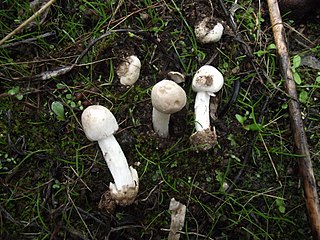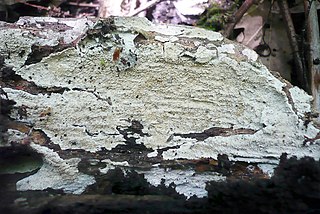
Torrendia is a genus of agaric fungi in the family Amanitaceae in part defined by being sequestrate. By molecular analyses the genus was shown to be part of Amanita and has now been placed in synonymy with Amanita. The type species, Torrendia pulchella, was first described by Italian mycologist Giacomo Bresadola in 1902, based on material collected in Portugal and sent to him by Camille Torrend. It has been renamed in Amanita as Amanita torrendii.
Portugaliae Acta Biologica is a biannual peer-reviewed scientific journal covering research in all areas of botany especially of Iberian and Macaronesian cryptogams. It is published by the Botanical Garden of the University of Lisbon and was established in 1944. Until 1999, the journal was published in two separate series, A and B, the first dedicated to morphology, physiology, and general biology, and the second to systematics, ecology, biogeography, and paleontology. The editors-in-chief are Amélia Martins-Loução, Fernando Catarino, and Ireneia Melo.
Revista de Biologia is a biannual peer-reviewed scientific journal covering research in biology, especially mediterranean and tropical ecology. It is published by the Botanical Garden of the University of Lisbon and was established in 1956. Until 1974, the journal was published jointly by the Botanical Gardens of Rio de Janeiro, Lisbon, Dundo, and Lourenço Marques. The editors-in-chief are Amélia Martins-Loução, Fernando Catarino, and Ireneia Melo.

Giacomo Bresadola 14 February 1847 – Trento 9 June 1929) was an eminent Italian mycologist. Fungi he named include the deadly Lepiota helveola and Inocybe patouillardii, though the latter is now known as Inosperma erubescens as this latter description predated Bresadola's by a year. He was a founding member of the Société mycologique de France.

The Steccherinaceae are a family of about 200 species of fungi in the order Polyporales. It includes crust-like, toothed, and poroid species that cause a white rot in dead wood.

The family Cavoliniidae is a taxonomic group of small floating sea snails, pelagic marine opisthobranch gastropod mollusks.

Steccherinum is a widely distributed genus of toothed crust fungi in the family Steccherinaceae.
Piloporia is a genus of two species of poroid fungi in the family Polyporaceae. The genus was circumscribed by Finnish mycologist Tuomo Niemelä in 1982, with P. sajanensis as the type species. The Indian species P. indica was added to the genus in 1988. P. sajanensis is found in Asia and Europe. In Asia, it is usually recorded on spruce, fir, and larch, while in Europe it is commonly found on spruce, but also on pine. Piloporia species cause a white rot in conifers and hardwoods.
Pseudopiptoporus is a genus of fungi in the family Polyporaceae. It was circumscribed by Norwegian mycologist Leif Ryvarden in 1980 with the type species Pseudopiptoporus devians. This fungus was originally published as Polyporus devians by Giacomo Bresadola in 1920. Pseudopiptoporus chocolatus was added to the genus in 2003.

Suillus bellinii, the Champagne bolete, is a pored mushroom of the genus Suillus in the family Suillaceae. It is found in coastal pine forests of southern Europe.
Jaapia is a genus in the monotypic family Jaapiaceae and order Jaapiales. The genus was first described by Italian mycologist Giacomo Bresadola in 1911, and contains two widely distributed species, J. argillacea and J. ochroleuca. The order was described in 2010.

The hydnoid fungi are a group of fungi in the Basidiomycota with basidiocarps producing spores on pendant, tooth-like or spine-like projections. They are colloquially called tooth fungi. Originally such fungi were referred to the genus Hydnum, but it is now known that not all hydnoid species are closely related.
Howard James Banker was an American mycologist. He received his PhD from Columbia University in 1908. Banker was an associate editor of the journal Mycologia starting from its establishment in 1909, until it became the official publication of the Mycological Society of America in 1933. He published several papers in the journal, including a revision of the North American Hydnaceae, which discussed 62 species in 10 genera. Banker died at his home in Huntington, New York, in 1940. The genus Bankera is named after him.

Hygrophorus marzuolus, commonly known as the March mushroom, is a species of fungus in the family Hygrophoraceae. It is known from Asia, Europe, and North America, where it grows on the ground in mixed forests at high elevations.
Andrew Price Morgan was an American botanist. He investigated the flora of the Miami Valley in Ohio. While his interest included flowering plants, as noted by his Flora of the Miami Valley, Ohio, his special interest was in fungi. Morgan worked as a teacher in Dayton. He studied the botany of the Great Miami River, publishing in 1878 the Flora of the Miami River, Ohio; Morgan also showed particular interest in mycology and bryology. A.P. Morgan was a mentor to the prominent American mycologist Curtis Gates Lloyd. His correspondence with Lloyd is stored in the Lloyd Library and Museum in Cincinnati. Lloyds portion of the correspondence is stored in the Ada Hayden Herbarium at Iowa state university. Morgans collection of preserved fungi can also be found at the Ada Hayden Herbarium along with Laura Morgans gouache illustrations of fungi that could not be preserved.

Hydnellum cristatum is a tooth fungus in the family Bankeraceae found in Europe and North America. It was originally described as a species of Hydnum by Italian mycologist Giacomo Bresadola in 1902. Joost Stalpers transferred it to the genus Hydnellum in 1993.

Skeletocutis amorpha is a species of poroid fungus in the family Polyporaceae, and the type species of the genus Skeletocutis.

Crustomyces subabruptus is a species of toothed crust fungus in the family Cystostereaceae.
Roseofavolus is a monotypic fungal genus in the family Polyporaceae. Circumscribed by Japanese mycologist Tsutomu Hattori in 2003, it contains the single poroid species Roseofavolus eos. This fungus was first described by English mycologist E.J.H. Corner as Grifola eos in 1989. It is found in the Malay Peninsula, Java, and Borneo.

Diplomitoporus flavescens is a species of poroid crust fungus in the family Polyporaceae.











